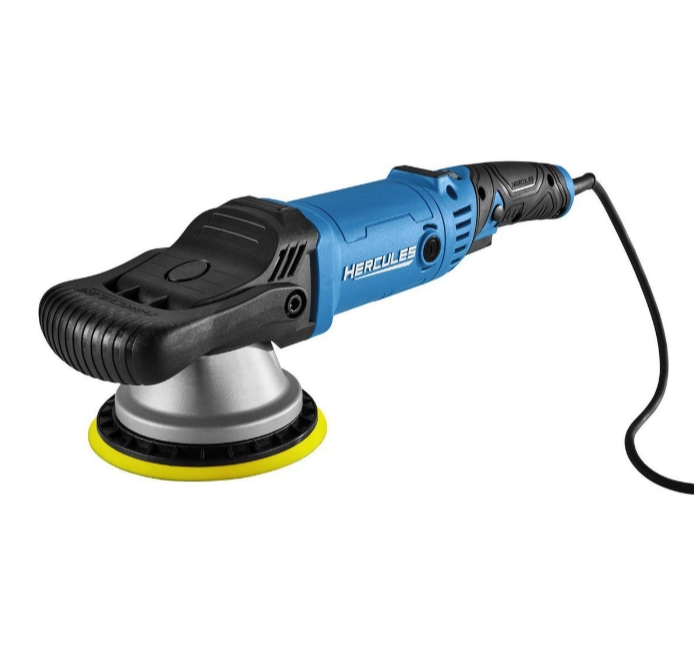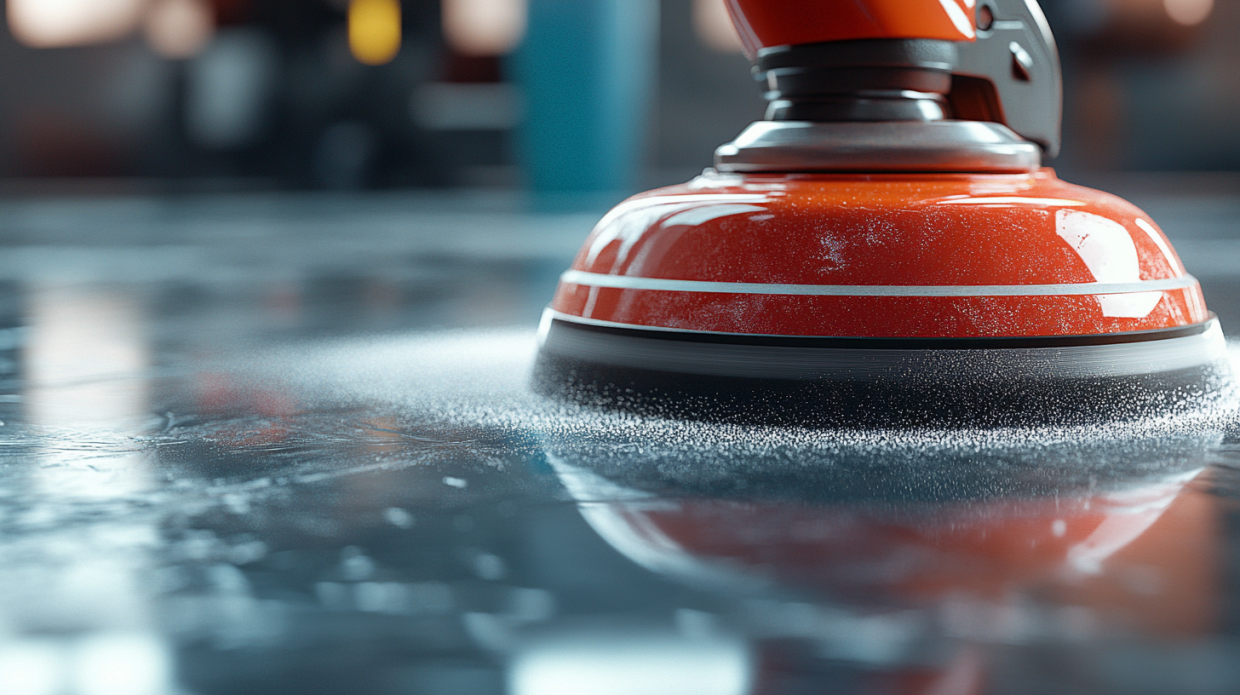
HERCULES 8 Amp 6 in. Forced Rotation Dual-Action Polisher
- HERCULES™ 8 Amp 6 in. Forced Rotation Dual-Action Polisher combines the power and speed of variable speed rotary buffer/polishers with the more user-friendly orbital motion of a dual action machine. The result is a powerful tool that allows even a novice to achieve professional results in less time. Six speed settings deliver a total speed range of between 3200 and 9600 oscillations per minute, for superior results in all types of detailing work.
- 3200 to 9600 OPM for precise and powerful correction
- Soft-start variable speed trigger prevents burning and reduces product sling
- Maximum Vibration Control (MVC) technology for reduced user fatigue
- Adjustable knob sets grip position for perfect balance and control
- 25 ft. durable rubber cord eliminates the need for extension cord
- Nonmarring touch points for placement anywhere
- Premium 6 in. hook and loop backing pad included
$119.99
When I first held the Hercules Dual Action Polisher in my hands, I had no idea it would completely transform my approach to detailing. After years of manual polishing and countless hours of arm-numbing labor, this power tool felt like unlocking a cheat code for achieving professional-grade results. Today, I’m sharing everything I’ve learned about this game-changing tool, from its basic features to advanced techniques that will have your car, boat, or any polishable surface gleaming like never before.
Understanding the Hercules Dual Action Polisher: The Basics
Let’s start with the fundamental question: What exactly is this tool? The Hercules Dual Action Polisher, often abbreviated as DA polisher, is a professional-grade power tool designed primarily for automotive detailing and surface restoration. Unlike traditional rotary buffers, the dual action mechanism simultaneously spins and oscillates in an orbital pattern, which dramatically reduces the risk of damaging your surfaces while providing exceptional polishing results.
My first encounter with the Hercules came after a particularly disappointing attempt to restore my 15-year-old sedan’s paint by hand. Despite hours of work, the swirl marks remained stubbornly visible, especially under direct sunlight. That frustration led me to research polishing machines, and the Hercules consistently appeared in recommendations for both beginners and professionals.
The beauty of this machine lies in its versatility. While primarily marketed for automotive use, I’ve successfully used mine on boats, granite countertops, and even some wood surfaces. The key is understanding its capabilities and limitations, which I’ll explore throughout this comprehensive guide.
Hercules vs. The Competition: How Does It Stack Up?
The market for dual action polishers is surprisingly crowded, with options ranging from budget-friendly units to professional-grade machines costing several hundred dollars. After extensively researching before my purchase, here’s how I found the Hercules positions itself among competitors:
When compared to industry leaders like the Rupes BigFoot or the FLEX XC 3401, the Hercules offers comparable performance at a significantly lower price point. While it may lack some premium features like digital speed displays or the ultra-smooth operation of top-tier models, the performance gap is much smaller than the price difference would suggest.
Against similarly priced competitors like the Torq TORQX or the Porter Cable 7424XP, the Hercules generally offers better build quality and a more powerful motor. The 900-watt motor particularly impressed me during extended sessions, maintaining consistent power without the bogging down I’ve experienced with some other mid-range polishers.
Where the Hercules truly shines is in the value proposition. After three years of regular use on multiple vehicles and surfaces, I’m convinced it offers the best performance-to-price ratio in the market. While premium brands may offer incremental improvements, the Hercules delivers 90% of the performance at roughly 60% of the cost.
Beginner-Friendly: My First-Time Experience
One of my initial concerns was whether I’d be able to master this tool without risking damage to my vehicle’s paint. Having now introduced several friends to machine polishing with the Hercules, I can confidently say it’s one of the most beginner-friendly polishers available.
The dual action mechanism is inherently safer than rotary polishers. The orbital movement means that even if you hold the machine in one spot for too long (a common beginner mistake), you’re unlikely to generate enough heat to burn through clear coat or damage the paint. This built-in safety feature gave me tremendous confidence during my early learning stages.
The variable speed control is another beginner-friendly feature I appreciated. Starting at lower speeds (settings 1-3) allowed me to get comfortable with the machine’s feel and behavior before gradually increasing to more effective polishing speeds. The speed dial is conveniently positioned for thumb adjustment while working, which I found intuitive.
The ergonomic design deserves special mention. At approximately 5.5 pounds, the Hercules is well-balanced and substantially lighter than many competitors. During my first full-vehicle polishing session (which took nearly 8 hours as a beginner), the comfortable grip and weight distribution prevented the hand fatigue I’d expected.
Features That Matter: What Sets the Hercules Apart
After extensive use, several features of the Hercules Dual Action Polisher have proven particularly valuable:
1. Powerful 900-watt motor: This provides consistent power delivery even under load, which I’ve found crucial when working with more aggressive compounds on harder clear coats.
2. 6-inch backing plate: The standard size accommodates the most commonly available pads while providing an efficient working area. I’ve found this size perfect for most automotive applications, balancing coverage with control.
3. Variable speed control (1000-6400 OPM): The wide range allows for everything from applying waxes at low speeds to serious correction work at higher settings. The dial is intuitively positioned and offers satisfying tactile feedback when adjusted.
4. Vibration reduction system: This may be my favorite feature during long sessions. While no dual action polisher is completely vibration-free, the Hercules does an admirable job minimizing fatigue compared to other models I’ve tried in this price range.
5. 15-foot power cord: The generous cord length has saved me countless repositioning moves when working around vehicles. This may seem minor, but when you’re focused on maintaining consistent technique, not having to constantly search for outlets is a significant quality-of-life improvement.
6. Quick-change backing plate system: Switching between different size backing plates (5-inch for tighter areas, 6-inch for open panels) is tool-free and takes seconds. This versatility has proven invaluable in real-world applications.
The Cost Factor: Investment vs. Value
Let’s talk about the elephant in the room—price. The Hercules Dual Action Polisher typically retails between $149-$189 depending on whether you purchase it individually or as part of a kit with additional accessories. This positions it firmly in the mid-range category, above entry-level consumer models but well below professional-grade options.
When I first considered purchasing, this represented a significant investment for a hobby detailer. However, after calculating the cost of professional detailing services (typically $300-$500 for comparable correction work on a standard vehicle), the Hercules paid for itself during its first complete detail job.
For professionals or serious enthusiasts, the value proposition becomes even stronger. The durability I’ve experienced suggests this isn’t a tool you’ll quickly outgrow or need to replace, making the initial investment even more reasonable.
If budget is a primary concern, I recommend looking for bundle deals that include essential accessories like backing plates and starter pads. These packages often represent better value than purchasing components separately and give you everything needed to start working immediately.
Surface Compatibility: Beyond Automotive Applications
While primarily designed for automotive detailing, I’ve successfully used my Hercules on numerous surfaces with excellent results:
Automotive paint: This is the primary application, and where the Hercules truly excels. I’ve used it on everything from modern clear coats to older single-stage paints with appropriate technique adjustments.
Marine gel coats: My neighbor’s boat restoration project introduced me to using the Hercules on fiberglass and gel coat surfaces. The results were impressive, bringing back the deep gloss that years of sun exposure had diminished.
Granite and marble: With careful pad selection and appropriate compounds, the Hercules effectively removed etching and restored shine to natural stone surfaces. I successfully renovated my kitchen countertops after a particularly aggressive cleaning product left dull spots.
Acrylic and plastic surfaces: Using finishing pads and fine polishes, I’ve successfully removed scratches from plastic trim pieces and even restored cloudy headlights to crystal clarity.
Metal surfaces: For aluminum, stainless steel, and chrome components, the Hercules has proven effective at removing oxidation and restoring shine when paired with metal-specific compounds.
The key to success on non-automotive surfaces is understanding that the technique requires adjustment. Lower speeds, lighter pressure, and careful product selection become even more critical when venturing beyond car paint.
Dual Action vs. Rotary: Understanding the Crucial Difference
Before purchasing the Hercules, I extensively researched the fundamental differences between dual action and rotary polishers. This distinction is critical for anyone considering entering the world of machine polishing.
Rotary polishers operate with a direct-drive spinning motion, generating significant heat and cutting power. While effective in experienced hands, they carry a substantial risk of burning through paint or creating holograms (visible circular marks) when used improperly. These tools are generally recommended only for professionals with significant experience.
In contrast, dual action polishers like the Hercules combine rotation with an orbital oscillating movement that mimics hand polishing while adding machine efficiency. This design inherently reduces heat buildup and makes it nearly impossible to burn through paint during normal operation—a crucial safety feature for beginners and enthusiasts.
The tradeoff comes in correction speed and power. A rotary can often achieve results faster, particularly on severely neglected surfaces. However, the learning curve is significantly steeper, and the risk of damage much higher.
After three years using the Hercules, I’ve never encountered a situation where I felt limited by the dual action design. Even when tackling heavily oxidized paint on neglected vehicles, the Hercules proved capable of achieving professional results with the appropriate pads, compounds, and a bit more patience.
Warranty and Customer Support: Peace of Mind
The Hercules Dual Action Polisher comes with a standard 1-year manufacturer warranty covering defects in materials and workmanship. While this isn’t the longest warranty in the industry (some premium brands offer 2-3 year coverage), I’ve found it adequate given the tool’s durability.
My personal experience with customer support has been limited to a single inquiry about recommended backing plate sizes. The response was prompt and helpful, though I can’t speak to how they handle warranty claims as I’ve never needed to make one.
Based on community feedback in detailing forums, the general consensus suggests that warranty support is straightforward when needed. Several users reported positive experiences with replacement parts being shipped quickly when defects were identified.
For added peace of mind, some retailers offer extended protection plans for an additional cost. Given the mechanical nature of the tool and my positive experience with durability, I personally didn’t opt for extended coverage, but it might be worth considering if you plan particularly heavy usage.
Compatible Accessories: Expanding Your Arsenal
One significant advantage of the Hercules is its compatibility with industry-standard accessories. The 5/16″ thread backing plate mounting system accepts virtually all mainstream backing plates and accessories without requiring proprietary components.
Through extensive experimentation, I’ve found these accessories particularly valuable with the Hercules:
Backing plates: While the standard 6-inch backing plate works for most applications, adding a 5-inch plate for curved panels and a 3-inch spot backing plate for tight areas dramatically increases versatility. These typically cost $15-$25 each and are well worth the investment.
Foam pads: I’ve achieved excellent results with both Lake Country and Chemical Guys foam pads. A starting set of cutting, polishing, and finishing pads covers most correction needs. Expect to invest $30-$60 for a complete set depending on brand and quantity.
Microfiber pads: For more aggressive correction on harder paints, microfiber cutting pads paired with the Hercules have provided results comparable to what I’ve seen from professional detailers.
Extension cord: While the 15-foot cord is generous, a quality 12-gauge extension cord is invaluable for larger properties or garage setups without convenient outlets.
Pad cleaning tools: A pad washer or cleaning brush specifically designed for polishing pads will extend pad life and maintain optimal performance. This was an accessory I initially overlooked but now consider essential.
Most impressively, I’ve never encountered an accessory compatibility issue with the Hercules. The standardized mounting system means you can confidently purchase pads and plates from virtually any reputable detailing brand without concerns about fit.
Effective Usage Techniques: Lessons From My Experience
After countless hours with the Hercules, I’ve developed a workflow that consistently delivers excellent results. Here’s my process refined through experience:
1. Preparation is crucial: Always work on clean, cool surfaces in shaded areas. I thoroughly wash and clay the vehicle before polishing to remove surface contaminants that could cause scratching during the polishing process.
2. Start with test spots: Before committing to an entire panel, I create small test sections (typically 2’x2′) to evaluate the combination of pad, compound, and machine speed. This prevents disappointment and potential damage.
3. Work section by section: I divide larger panels into manageable sections and complete each fully before moving on. Typically, a 2’x2′ area works well with the Hercules’ 6-inch pad.
4. Speed selection matters: For most correction work, I operate between speeds 4-5 (approximately 5000-5500 OPM). Lower speeds (1-3) work well for applying waxes or sealants, while maximum speed is reserved for heavy cutting on particularly difficult defects.
5. Let the machine do the work: One of my earliest mistakes was applying too much pressure. The Hercules works best with light pressure—just enough to slightly compress the foam pad. Excessive pressure actually







